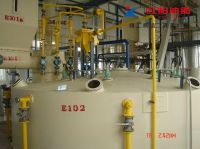153-0373-2222
138-3908-0089
Soybean oil is typically obtained through various methods such as pressing and extraction, resulting in crude oil with many impurities. This crude oil is then refined to produce edible refined oil.
Pressing methods can be divided into ordinary pressing and screw pressing. Ordinary pressing is a method of applying pressure to soybeans. This method is now rarely used, especially in large-scale industrial production. Screw pressing involves the installation of a screw shaft in a horizontal cylinder, where pre-processed soybeans enter the screw press. As the soybeans move forward, they are squeezed to extract the oil. This method allows for continuous production but proteins undergo significant changes due to friction and heat generation during the pressing process.
Oil extraction by the extraction method utilizes solvents that can dissolve oil. Through wetting, penetration, molecular diffusion, and convection diffusion, the oil is extracted from the meal. The mixed oil, consisting of solvent and oil, is then separated, and the solvent is recovered to obtain crude oil. The commonly used solvents in China's oil industry include hexane and light gasoline. Light gasoline is the most widely used solvent, but it has the drawback of being flammable and explosive, with a complex composition and a wide boiling range. The extraction method yields an oil extraction rate of up to 99%.
Differences between Pressing Oil and Extraction Oil
1. Different Processing Techniques
Pressing oil is produced using the "physical pressing method," while extraction oil is produced using the "chemical extraction method." the physical pressing method requires high quality raw material and then go through selecting seeds, remove impurities, crushing, steaming and then pressing to get oil separated from the oil seeds. In the whole process, it adopts cooking oil seeds, then pressing by oil press and finally filtrate by high-tech natural purification method. This method can help to retain soybean’s original flavor and the oil have rich aroma and rich vitamin E, can be stored longer and contains no additives, solvent residues or soap content. It is a pure natural green food produced by combining modern and traditional techniques.
Extraction oil is produced using the organic solvent extraction method, which involves the complete mixing of oilseeds with organic solvents such as "No. 6 light gasoline" (commonly referred to as "No. 6 solvent oil") and then extracted. Therefore, it is difficult to completely remove toxic organic compounds like ethane, and it can only be safely consumed by meeting extremely strict refining standard. Otherwise, it can easily harm the human body. However, during high-temperature refining, some of the nutrient vitamins are inevitably lost. In China, except for a portion of soybean oil produced by pressing, most sunflower oil, soybean oil, cottonseed oil, and other oils are mainly produced using the "No. 6 light gasoline" extraction method.
2. Different Nutritional Components
Pressing soybean oil has a full range of color, aroma, and taste, retaining various nutritional components. Extraction oil is colorless and odorless, and most of its nutritional components are destroyed during processing. The new standard for edible oils drafted by the National Grain Bureau has been implemented, canceling the old standards from 1986 and 1988. The new standard stipulates that pressing soybean oil and extraction soybean oil must be labeled with "pressing" and "extraction" respectively on the product label. With the progress of society and the improvement of people's living standards, the pursuit of nutrition and health in diet has become a goal. Making the soybean oil production process transparent is to inform consumers about the production process of soybean oil, giving consumers the right to know and choose.
3. Different Requirements for Raw Materials
"Pressing soybean oil" uses the pure physical pressing method, retaining the original flavor of soybeans. Therefore, the requirements for soybean raw materials are very strict, requiring freshness, low acid value, and peroxide value. As a result, the price is relatively high. Additionally, since only pressing is performed, the residual oil in soybean meal is high, and the oil yield from pressing is relatively low. Consequently, the price of pressing soybean oil is relatively high.



























































